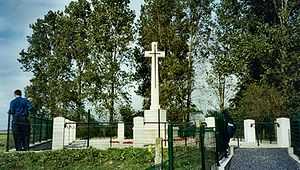RE Grave, Railway Wood
| RE Grave, Railway Wood | |
|---|---|
| Commonwealth War Graves Commission | |
 | |
| Used for those deceased November 1915 – August 1917 | |
| Established | 1915 |
| Location |
50°51′08″N 2°56′13″E / 50.85222°N 2.93694°E near Ieper, West Flanders, Belgium |
| Designed by | A J H Holden |
| Total burials | 12 |
| Unknown burials | 0 |
| Burials by nation | |
| Burials by war | |
|
World War I: 12 | |
| Statistics source: CWGC | |
RE Grave, Railway Wood is a Commonwealth War Graves Commission (CWGC) memorial and war grave located in the Ypres Salient on the Western Front. It is located on the Bellewaerde Ridge near Zillebeke, about 4 kilometres east of Ypres, and a little north of Hooge. The area was the site of intensive fighting in the First World War.
History

The Royal Engineers grave at Railway Wood marks the site where twelve soliders (eight Royal Engineers of the 177th Tunnelling Company and four attached infantrymen) were killed between November 1915 and August 1917 whilst tunnelling under the hill near Hooge during the defence of Ypres. The men were trapped underground and their bodies not recovered, and after the war, the memorial was erected on the hill.[1][2]
The site is unusual for being both a cemetery and a memorial. Because the bodies remain underground, the cemetery has no individual gravestones, and the names of the twelve men who died are inscribed on the Cross of Sacrifice instead. The inscription across three sides of the Cross of Sacrifice reads: Beneath this spot lie the bodies of an officer, three NCOs and eight men of or attached to the / 177th Tunnelling Company Royal Engineers / who were killed in action underground during the defence of Ypres between November 1915 and August 1917.
The grounds were assigned to the United Kingdom in perpetuity by King Albert I of Belgium in recognition of the sacrifices made by the British Empire in the defence and liberation of Belgium during the war and are administrated as a war cemetery by the Commonwealth War Graves Commission.
Tunneling
All sides would engaged in vigorous mining and counter-mining duels under rises in the Ypres Salient and the Somme. Specialist tunnelling companies, like the 177th, usually made up of men who had been coal miners in civilian life, would dig tunnels under no man's land and beneath the enemy's trenches. These mines would then be packed with explosives and detonated, producing a large crater. The crater served two purposes: it could destroy or breach the enemy's trench and, by virtue of the raised lip that they produced, could provide a ready-made "trench" closer to the enemy's line. When a mine was detonated, both sides would race to occupy and fortify the crater.
Lieutenant Boothby's letters
The officer mentioned in the inscription on the Cross of Sacrifice was Second Lieutenant Charles Geoffrey Boothby (13 December 1894 – 28 April 1916), service number 147252, from near Birmingham. He first attended Clayesmore School, then Christ College, Brecon, between 1909 and 1913. In the autumn of 1913, he entered Birmingham University, and spent a year studying dentistry. He was just short of his 20th birthday when he applied for a commission in December 1914. A year later he was seconded from 8th Battalion, South Staffordshire Regiment to the Royal Engineers. Also in 1915, when he was twenty-one, Boothby had just met eighteen-year-old Edith Ainscow. They exchanged love letters over a period of 18 months until Boothby was reported missing in action in spring 1916, having been blown up by a German mine at Railway Wood on the Bellewaerde Ridge near Ypres. The letter exchange between Boothby and Ainscow survived the war and was eventually published by Edith's son Arthur Stockwin in 2005.[3]
Further reading
- Arthur Stockwin (ed.), Thirty-odd Feet Below Belgium: An Affair of Letters in the Great War 1915-1916, Parapress (2005), ISBN 978-1-89859-480-2 (online).
References
- ↑ www.wo1.be accessed 19 June 2006
- ↑ wo1.be, accessed 19 June 2006
- ↑ Arthur Stockwin (ed.), Thirty-odd Feet Below Belgium: An Affair of Letters in the Great War 1915-1916, Parapress (2005), ISBN 978-1-89859-480-2 (online)
External links
-
- Cemetery register: Details
- Reports
- Plans
- Photographs. CWGC.
- Detailed photos of the site
- Biographies of the 12 soldiers
- R.E. Grave Railway Wood at Find a Grave
- 1914-1918.net
- Royal Engineers Museum